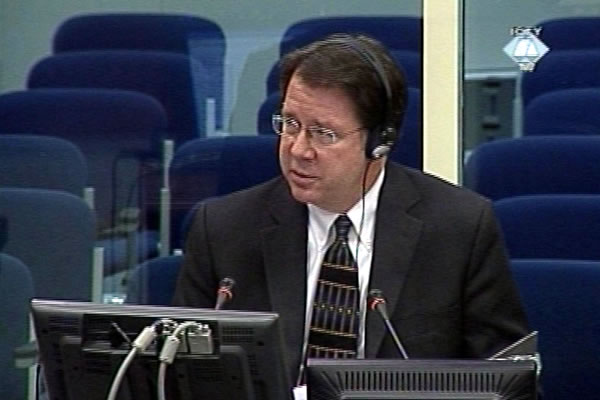Home
SYSTEMATIC CAMPAIGN OF ARSON AND DESTRUCTION
Edward Flynn, head of the UN Human Rights Action Team, began his evidence at the trial of Croatian generals charged with crimes in Operation Storm. From 7 August to 17 August 1995, he witnessed the looting, arson, destruction and discovery of bodies of civilians killed in Sector South in Krajina
 Edward Flynn, witness in the Gotovina trial
Edward Flynn, witness in the Gotovina trial ‘It would be accurate to say that Krajina is on fire’, says the report by the UN Human Rights Action Team (HRAT) on 13 August 1995.
The author of the report, Edward Flynn, testified today at the trial of Croatian generals Gotovina, Cermak and Markac, indicted for crimes committed in Operation Storm and its aftermath. On that day, Flynn recounted, he was on his way to Benkovac via Kistanje. He saw dozens of burned down houses and fields and with at least ten ‘smoke clouds rising high above Benkovac’. Members of the UN mission to Krajina, Flynn said, got worried that day because the scale of the destruction and the area it covered were so large that this was turning into a systematic campaign. Flynn’s report went on to conclude that ‘the authorities are still not taking any measures to stop it’.
Edward Flynn is now a high-ranking official in the Anti-Terrorism Committee of the UN Security Council. From 7 August to 17 September 1995, he headed one of the HRAT teams in the UN mission in Knin. He saw the looting, arson, destruction and the discovery of bodies of civilians killed in the region, and he reported those incidents to his superiors on a daily basis. More importantly for the Tribunal, Flynn also informed the Croatian authorities about these events. His primary contact was the accused Ivan Cermak, who was the Knin military governor at the time.
More than twenty of his daily or weekly reports on the looting, arson, destruction, killing and other humanitarian law violations that he saw in the forty days of his tour of duty in Krajina were tendered into evidence. Video recordings and photographs of burned down houses and dead civilians taken during his patrols are among the exhibits.
On their visit to the village of Grubori in the Plavno Valley on 25 August 1995, Flynn’s action team was accompanied by a UN cameraman who filmed the burned down houses, bodies of dead civilians and crying women who didn’t know what happened to their husbands and other relatives. On that day, Flynn saw two bodies while his colleagues discovered the bodies of another three victims the next day.
Flynn immediately informed Cermak’s principal deputy about this, expecting that the authorities would conduct a crime scene investigation. Several days later, Cermak informed the HRAT that the civilians were killed in the fighting in the village of Grubori which was ‘a Chetnik stronghold’. An investigation would follow, Cermak said. Two weeks later, Flynn visited the village again. He saw two bullet casings that were still in the room where he saw the body of a man, and this led him to conclude that there had been no serious investigation in this case.
The HRAT report of 8 September 1995 notes that the issue of looting, arson and killing was raised in a meeting with Cermak. General Cermak replied that ‘he couldn’t deny there is serious anarchy in the sector’, adding that the authorities were taking appropriate measures. He also asked the UN official to keep him informed about the crimes. To Flynn, Cermak’s words were ‘belated, insincere and implausible’; Cermak was regularly informed by the HRAT about what its patrols had found and if he wanted to, he could have easily seen for himself what was going on in the territory under his power.
Linked Reports
- Case : Gotovina et al. - "Operation Storm"
- 2008-04-08 ONE PLUME OF SMOKE FROM SEVEN DIFFERENT ANGLES
- 2008-04-07 BOTH PARTIES SHOW VIDEO FOOTAGE AT OPERATION STORM TRIAL
- 2008-03-14 ARMY ‘WORSE’ THAN POLICE
- 2008-04-10 DEFENSE: CERMAK DID NOT ISSUE ORDERS – HE COORDINATED THINGS
- 2008-04-11 ‘ORGANIZED’ OR ‘ORDERLY’ MOVEMENT OF REFUGEES
- 2008-04-14 HOW MANY DEAD IN KNIN HOSPITAL?
